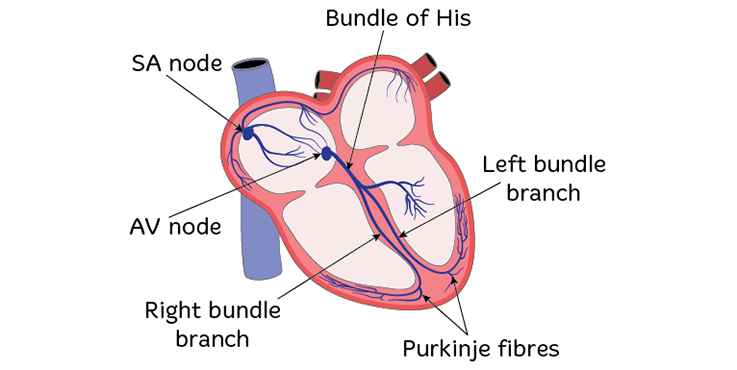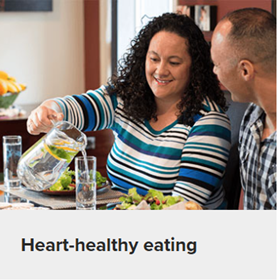Page information and credit to HEART FOUNDATION NZ
FEBRUARY - HEART HEALTH MONTH
Heart Health Overview
The heart is a vital organ in the human body responsible for pumping blood throughout the circulatory system. It is a muscular organ located in the chest, slightly to the left of the center. The heart has four chambers: two atria (upper chambers) and two ventricles (lower chambers). These chambers work together to ensure that oxygen-rich blood is delivered to the body's tissues and organs, while oxygen-poor blood is sent to the lungs for oxygenation.
Heart disease is the leading cause of death globally, but many of its risk factors are preventable. The Heart Foundation emphasizes the importance of maintaining a healthy lifestyle to protect your heart.
By adopting healthy habits, you can significantly reduce your risk of heart disease and improve your overall well-being. Here are some key points:
SHOW YOUR BIG HEART
~
SHOW YOUR BIG HEART ~
REDUSE SALT CONSUMPTION
DO DAILY EXERCISE
CHOOSE HEALTHY FOOD
DON’T SMOKE OR VAPE
LIMIT ALCOHOL CONSUMPTION
MAINTAIN A HEALTHY WEIGHT
KNOW WHAT SIGNS TO LOOK FOR
A piece written by our very own Dr. McKee. Imagine rapping this as you read the lyrics
HANGING OUT WITH THE BROS
THEN SUDDEN I GET PAIN
IN CHEST
FEELS HEAVY, LONG, HARD LIKE SOMETHING CRUSH
I SAY - NO BROS - WHAT’S THE RUSH.
I ATE A PICKLE LAST NIGHT, ITS INDIGESTION.
HEY, SAYS BROS, THAT’S THE WRONG SUGGESTION
CALL 911, CALL HELP TILL IT COMES
YOU’RE GOING ED, YOU’RE NOT GOING HOME
LONG + STRONG GET GONE
THIS IS NOT A TSUNAMI
THE PAIN IN YOUR CHEST WAS NOT THE SALAMI
SO OFF TO THE HOSPITAL
THOSE DUDES IT’S CRITICAL
THEY WIRE ME TO MAINS
BUT NO EASE TO THOSE PAINS
MIND THESE THREADS
DON’T CUT THAT SHIRT
HEY IS THIS GONNA HURT?
THE BEAT GOES ON - JUST TWICE AS FAST
BUT SEE THIS PAIN
HOW LONGS IT GONNA LAST
DON’T CUT & RUN
THIS PAIN IN MY CHEST IS SURE NO FUN
IT FEELS LIKE I LOST MY RHYTHYM
OMG… I’M GOING TO HEAVEN!
BUT NO - SUDDEN SHOCK
AND I’M BACK SO FAST
IT’S BACK TO THE FUTURE
AND SO, IT’S TRUE - I HAVENT PASSED
SO FORGET LAMAR & DRAKE
WHEN IT COMES TO YOUR HEART
JUST PASS ON THE CAKE
LESS CARBS - MORE GREENS, KEEPS US TOGETHER - NOT APART
SO LIVE CLEAN AND NO SMOKE TO LOOK AFTER YOUR HEART
AND I HOPE YOU ENJOY THIS SONG
ONLY THING….
IT’S JUST TOO LONG….
HOW THE HEART WORKS
The human heart pumps blood to every part of your body. Learn about the different parts of the heart and watch the video about how a healthy heart works.
Your heart is the pump which powers your body. It supplies blood carrying oxygen and nutrients to every cell, nerve, muscle and vital organ in your body.
It sits in your chest between your lungs, slightly to the left of centre, and is protected by your rib cage.
Your heart is about the size of your clenched fist and weighs about 300 grams (that's just over half a packet of butter).
Watch this step-by-step video of how the heart works
What are the parts of the heart?
Your heart is a bit like a house. It has:
outer walls (the outer muscle or myocardium)
plumbing (arteries and veins)
electrics (the electrical conduction system).
Heart walls
The walls of your heart are made of powerful muscle tissue, which squeezes and relaxes to pump blood around your body. This muscle tissue is divided into three layers.
The endocardium (the inside layer).
The myocardium (the muscular middle layer).
The epicardium (the protective outer layer).
Heart chambers (rooms)
Your heart is made up of four chambers, two on the right and two on the left. These are like the rooms of your house.
The top two chambers are called the left and right atrium and the bottom two are called the left and right ventricles.
They are divided by a thin wall called the septum.
Heart valves (the doors between the rooms)
There are four valves that act like doors to keep blood flowing in the right direction. They open and close as your heart pumps.
The valves only open one way. This stops blood flowing in the wrong direction between the chambers of your heart.
The two valves that sit between the upper and lower chambers of the heart are called the atrioventricular, or AV valves.
The tricuspid valve is the door between the right atrium and ventricle.
The mitral valve is the door between the left atrium and ventricle.
The other two valves are the doors out of the ventricles. They are called semilunar, or SL valves.
The aortic valve is the door out of the left ventricle into the aorta.
The pulmonary valve is the door out of the right ventricle into the pulmonary artery.
The blood vessels (the plumbing)
Blood travels between the heart and the lungs and the rest of the body, via a network of pipes called the blood vessels. There are three main types of blood vessels.
Arteries, which carry oxygenated blood from your heart to the rest of your body.
Veins, which carry the de-oxygenated blood back to your heart and lungs.
Capillaries, the small vessels where oxygenated and de-oxygenated blood is exchanged.
How the heart pumps
Your conduction system sends the electrical signals which trigger the heart to pump blood around the body, and to and from the lungs.
Blood which has used all its oxygen is returned to the right side of the heart, via large veins called the inferior and superior vena cava. From there it is pumped to the lungs, via the pulmonary artery.
Once the blood has received oxygen from the lungs, it travels through the pulmonary veins into the left side of the heart. From here it is pumped back out around the body, via the aorta.
The heart's conduction system (the electrics)
Your heart has its own electrical wiring system (conduction system), which keeps it beating. This conduction system includes:
the sinoatrial (SA) node (or sinus node). This is your body’s own internal pacemaker, that produces electrical signals to make your heart beat
the atrioventricular (AV) node. This is a node that passes on the electrical signals from the upper chambers of the heart (artia) to the lower ones (ventricles)
the bundle of His, the left and right bundle branches, and the Purkinje fibres. These act like electrical wiring that communicate the signals around the heart.
The SA node sends an electrical signal that makes the upper chambers of the heart (atria) contract (squeeze). This pushes blood out of the atria and into the lower chambers of the heart (ventricles).
The electrical signal passes from the atria to the AV node. From there, it passes through the bundle of His and into the right and left bundle branches.
Finally, the signal travels down the Purkinje fibres, causing the ventricles to contract. This pushes blood out of your heart to your lungs and the rest of your body.
How the heart pumps
Your conduction system sends the electrical signals which trigger the heart to pump blood around the body, and to and from the lungs.
Blood which has used all its oxygen is returned to the right side of the heart, via large veins called the inferior and superior vena cava. From there it is pumped to the lungs, via the pulmonary artery.
Once the blood has received oxygen from the lungs, it travels through the pulmonary veins into the left side of the heart. From here it is pumped back out around the body, via the aorta.
The coronary arteries
The heart has its own network of blood vessels, which supply it with the blood it needs to keep pumping.
These vessels are called the coronary arteries. They branch off the body’s largest artery, the aorta, and lie on the outside of your heart.
Narrowing in one of the coronary arteries can lead to angina and a blockage can cause a heart attack.
What is your pulse?
The pulse you can feel, for example in your wrist or neck, is the heart pumping blood. You can measure the rate and rhythm of your heart by taking your pulse
Your pulse, or heart rate, can tell you a lot about your heart. Learn about normal and abnormal heart rates and find out how to check your own pulse.
WELLBEING
Healthy living is all about choices, some big ones and lots of little ones.
There's heaps you can do to keep your heart healthy - whatever your age.
We are all different shapes and sizes. Your health professional may measure your BMI or waist alongside other factors like your blood pressure to get an overall picture of your heart health.
If you’re concerned about your weight, focus on improving your health with our lifestyle tips.
Are you eating right to support the health of your heart?
Here you will find tips, tools and resources for healthy eating for you and your whānau.
Heart Foundation recipes are designed by nutrition professionals to take the fuss out of healthy eating.
From quick and easy to culinary delights, we have something for everyone.
Search or browse through our recipe selection for your next meal.
You have an important role to play in your health.
The choices you make every day can change your risk of heart disease.
Find out what you can do to manage your risk of heart attack and stroke.
Are you building movement into your day?
Here you will find our latest advice, tips and tools to help you to sit less and move more.
Click on the ‘Start quiz’ button to get ticking.
You can even share with friends and family to see who is the most heart smart!
































